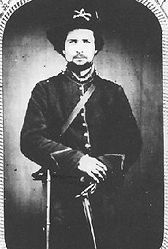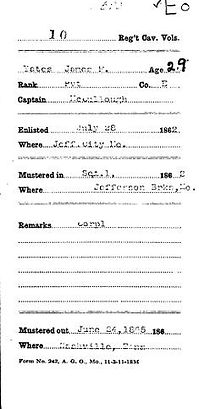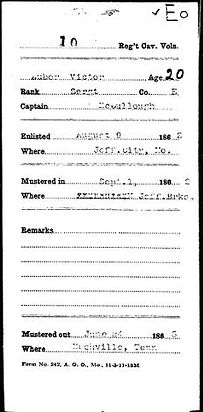Office Hours
Tuesday and Thursday
9:30 a.m. - 11:30 a.m.
12:30 p.m. - 3:00 p.m.
Closed
Monday-Wednesday-Friday
Saturday and Sunday
Museum Hours
By Appointment
Only
Admission Fees
Adults (18+) $5
Seniors (55+) $4
Children (K-12) $3
Children (5 & under) Free
Members Free
Museum is open by appointment Only
(Call 573-635-1850)
Civil War Room and Information
Union Soldier Biographical Sketch
Co. D, 68th Regt., U.S. Colored Infantry
Isaac Adams was born in Callaway County in 1847 to a slave woman (name unknown) who was owned by John B. Adams. He enlisted in Company D, 68th Regiment, U. S. Colored Infantry on March 1, 1864 at Jefferson City. He was 17 years old, stood 5 feet 3 inches tall and was listed as a mulatto. He was mustered into service at Benton Barracks, Missouri and spent the next two years fighting with his unit.
During the months of May and June, 1864, Isaac was in the Camp Hospital in Memphis, TN. According to his military records, this was the only time he was absent from his regiment. On February 5, 1866, he was discharged from service at Camp Parapet, LA near New Orleans.
He returned to the home of his former owner, John B. Adams, in Callaway County and lived for awhile. Adams made claim for compensation from the United States government for Isaac’s years of military service stating, “This claimant obtained his title to him in the following manner—to wit: the said Isaac was born my slave.”
On December 24, 1875, Isaac married Harriet Henderson of Cedar City, MO. She was born in Callaway County in 1846. Isaac and Harriet were the parents of seven children: Virgie born 1877, William b. 1879; Florence b. 1881; Ora b. 1883; Dona b. 1885; Nellie b. 1887; and Zepher b. 1889. Isaac and Harriet reared their children at Cedar City across the river from Jefferson City.
In 1894, he made application for a pension, due to a disability he acquired while in military service in 1864. There was an injury to his left hand with the middle finger bent to the palm. This may have been the reason he was in the hospital for two months in 1864.
Isaac died in Jefferson City where they were living in June 1902, leaving Harriet with the younger children to rear alone. She applied for a widow’s pension after Isaac’s death. Her friends, William and Millie Wilson of Cedar City, wrote an affidavit on her behalf stating she possessed no property except a few household goods and had no income except her daily labor of taking in washings. After much red tape she received a $30 monthly pension. Harriet died in June 1927 at the age of 81 years.
Isaac Adams
Provost, MO State Militia Vol.
William Anderson was born in County Down Ireland in 1833, the son of Jane Cunningham and Hugh Anderson. He immigrated to America at the age of fifteen and worked in Pennsylvania and Ohio before coming to Cole County around 1858.
Upon the outbreak of the Rebellion he enlisted in the Missouri State Militia and was provost guard at Jefferson City. Afterward he went to Waynesville, MO then to Houston, TX and finally to Raleigh, MO where he did guard duty for the stage line and was also provost. He took part in the campaign against Price when he made his raid through Missouri. Anderson was wounded at Booneville by a minnie-ball and was treated in the hospital at Jefferson City for a number of months. He rejoined his regiment at Raleigh and was mustered out of service March 31, 1865.
William returned to Jefferson City and worked for the Missouri Pacific Railroad for about seven years. During this time he met Miss Minerva Ann Fletcher of Center Town and they were married March 13, 1871. The couple lived in Jefferson City until the following year when they moved to a farm of 140 acres, two and a half miles south of town. They later added another 140 acres to the farm and built a frame house on the property.
Seven children were born of this union and after living on the farm for about twelve years, the family moved back to Jefferson City. Mr. Anderson was a staunch Republican in politics and he and his family were members of the Cumberland Presbyterian Church.
William Anderson
Provost, MO State Militia Vol.
William Anderson was born in County Down Ireland in 1833, the son of Jane Cunningham and Hugh Anderson. He immigrated to America at the age of fifteen and worked in Pennsylvania and Ohio before coming to Cole County around 1858.
Upon the outbreak of the Rebellion he enlisted in the Missouri State Militia and was provost guard at Jefferson City. Afterward he went to Waynesville, MO then to Houston, TX and finally to Raleigh, MO where he did guard duty for the stage line and was also provost. He took part in the campaign against Price when he made his raid through Missouri. Anderson was wounded at Booneville by a minnie-ball and was treated in the hospital at Jefferson City for a number of months. He rejoined his regiment at Raleigh and was mustered out of service March 31, 1865.
William returned to Jefferson City and worked for the Missouri Pacific Railroad for about seven years. During this time he met Miss Minerva Ann Fletcher of Center Town and they were married March 13, 1871. The couple lived in Jefferson City until the following year when they moved to a farm of 140 acres, two and a half miles south of town. They later added another 140 acres to the farm and built a frame house on the property.
Seven children were born of this union and after living on the farm for about twelve years, the family moved back to Jefferson City. Mr. Anderson was a staunch Republican in politics and he and his family were members of the Cumberland Presbyterian Church.
William Logan Bennett


Pvt. 42nd Reg’t., EMM, Co. H
William Berendzen, a native of Hanover, Germany, was born July 29, 1825, city of birth is unknown. He immigrated to Taos, Missouri in 1846. On May 2, 1854, he married Anna Helena Sanning, daughter of Francis Leopold Sanning and Anna Margaretha Jansen. William and Helena had eleven Children. In about 1869 they moved their family to the Mary’s Home area of Miller County where they farmed. William died June 19, 1892; both he and Helena are buried there at Our Lady of the Snows Church Cemetery.
William Berendzen

Pvt. 26th Inf. Vol., Co. H.
John L. Brenner, a shoemaker by trade, was born in Bavaria Germany on May 29, 1829. He attended school until age 13 then began to learn the shoemaker’s trade. He worked as a shoemaker until his immigration to the U.S. in 1854. He landed in Baltimore, MD and made his way to New Albany, IN and thence to Osage City, MO which became his home.
At the outbreak of the Civil War, he served three months in the Home Guards then on December 16, 1861, enlisted in the 26th MO Infantry and served three years. He was discharged at Savannah, GA, January 10, 1865. He took part in the siege of New Madrid, siege of Corinth, the battles of Iuka, Port Gibson, Raymond, Jackson, Champion’s Hill, Mission Ridge, as well as others and was with Sherman on his march to the sea.
In 1853, Mr. Brenner married Margaret Schneider. They had 7 children: John H., Lawrence P., William J., Maggie, Ernestine, Kate and Barbara. After the war Mr. Brenner bought a farm near Osage City, MO where he lived until 1882, when he took charge of the post office at Osage City. Mr. and Mrs. Brenner were members of the Lutheran Church. In politics he was a Republican.
John L. Brenner
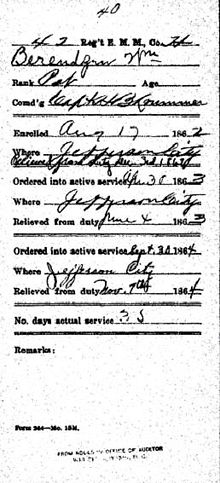

Provost, MO State Militia Vol.
William Anderson was born in County Down Ireland in 1833, the son of Jane Cunningham and Hugh Anderson. He immigrated to America at the age of fifteen and worked in Pennsylvania and Ohio before coming to Cole County around 1858.
Upon the outbreak of the Rebellion he enlisted in the Missouri State Militia and was provost guard at Jefferson City. Afterward he went to Waynesville, MO then to Houston, TX and finally to Raleigh, MO where he did guard duty for the stage line and was also provost. He took part in the campaign against Price when he made his raid through Missouri. Anderson was wounded at Booneville by a minnie-ball and was treated in the hospital at Jefferson City for a number of months. He rejoined his regiment at Raleigh and was mustered out of service March 31, 1865.
William returned to Jefferson City and worked for the Missouri Pacific Railroad for about seven years. During this time he met Miss Minerva Ann Fletcher of Center Town and they were married March 13, 1871. The couple lived in Jefferson City until the following year when they moved to a farm of 140 acres, two and a half miles south of town. They later added another 140 acres to the farm and built a frame house on the property.
Seven children were born of this union and after living on the farm for about twelve years, the family moved back to Jefferson City. Mr. Anderson was a staunch Republican in politics and he and his family were members of the Cumberland Presbyterian Church.
Dr. Bernard Bruns
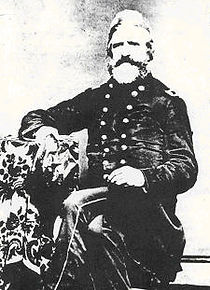

Company E, 10th MO Vol. Cav.
Henry (Heinrich) Bruns enlisted in September of 1862 the same month as his father, Dr. Bernard Bruns. On July 9, 1863, young Henry was mortally wounded at Iuka, Mississippi—the first Jefferson Citian killed in the war. His father died the following year of natural causes.
Captain Henry Bruns
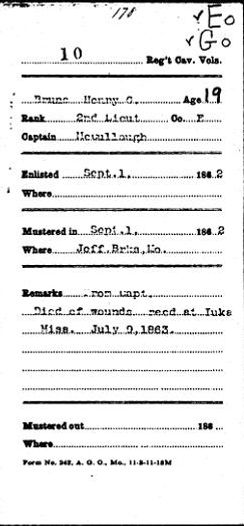
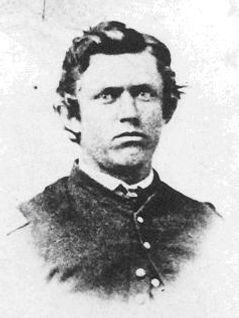
Fred Buehrle
4th Reg’t. Co. D
Fred Buehrle was born on March 4, 1837, the younger brother of Wendelin (1828-1914), grandfather of Henry (1896-1956) and builder of Buehrle’s Market (now Bob’s Market) at W. Main and Boonville Rd. Fred and Wendelin were both born in Baden, Germany, moving to Cole County some years before the war. Both fought on the Union side.
At the Battle of Wilson’s Creek, August 10, 1861, Fred was shot through the shoulder and right leg. Cole County suffered a number of casualties in this battle.
According to a later version of this event, many, if not most, were more serious than Fred Buehrle’s, but few were as embarrassing. Not only did one of the rebels shoot Fred in the buttocks, this event was actually witnessed by fellow soldiers from Jefferson City that knew Fred. Problem was, those fellows were on the other side! Temporarily leaving the infantry company he was leading, Confederate Captain James Levi Keown of Jefferson City rushed to Fred’s side when he saw him get shot, gave him water to drink and stayed with him until help arrived from the Union Side.
A reunion to rehash this event took place in Jefferson City August 10, 1911, 50 years later to the day between Fred Buehrle who was almost 80 years old and J. L. Keown, age 90 and two other local rebels, Waller Bolton and Tom Schwartzott. The event was duly reported in the Jefferson City News Tribune.
Buehrle also fought at the Battle of Carthage, MO. For many years following the Civil War, “Colonel” Buehrle, as he came to be called, served as the cannon squad leader at the Missouri State Capitol during July 4th celebrations.
Buehrle was married for over fifty years to Anna R. Kieselbach. He died March 25, 1915 in Kansas City, MO while attending a Grand Army of the Republic (GAR) convention. His military funeral in Jefferson City was attended by over 2,000 people. He is buried in Woodland Cemetery in Jefferson City.
Wendelin Buehrle
Sgt. 42nd Reg’t. EMM, Co. G
Wendelin Buehrle was born in the German Duchy of Baden in Jun3 1828. His father was a weaver and day laborer. Wendelin immigrated, with his brother Frederick, to America in 1852, settling in Ft. Wayne, IN where he married Margaret Bodtenschats, a native of Bavaria. The couple moved to Jefferson City in 1858 and settled in the Munichburg area. They were members of the German Evangelical Church.
When the Civil War began in 1861, Wendelin was 33 years old and the father of three children: Sophie, Margaret and Fredolin. He was a supporter of the Union cause and served in the 42nd Enrolled Missouri Militia on active military duty until 1863.
After the war he built a house on Washington Street near the Central United Church of Christ. Three more children were added to the family—Elizabeth, Mary and Emma. Mr. Buehrle made his living as a South Side merchant and later as a bricklayer.
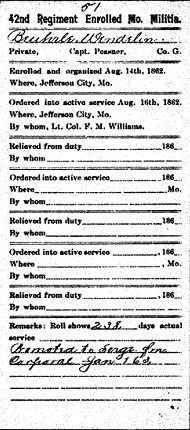

Charles F. Burger
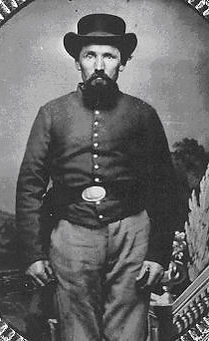
Sgt., 5th Reg’t. Cav. Vols., Co. E
Charles Burger enlisted March 25, 1862 and served under Capt. Charles B. Maus. During the course of his service, he also served in the 2nd and 10th Regiments under Captains Phelps and Burns.
Charles was captured by the enemy on November 1, 1864 and mustered out as a paroled prisoner.

Charles F. Clarenbach
Co. C, 72nd IL Infantry
Charles F. Clarenbach, was born in Osage County, MO, January 13, 1844, the youngest in a family of six children born to Peter F. and Wilhemina Hofins Clarenbach, natives of Germany. Following the death of his father, Charles worked on the family farm in summer and attended school in winter until eighteen years of age. His mother sold the farm in 1865 and bought 285 acres in Cole County, situated on a branch of Honey Creek.
In 1862, Charles enlisted in Company C, 72nd IL Infantry for three years and was discharged in Springfield, IL, July 15, 1865. He returned to his mother’s farm in Cole County and later clerked in a store in Jefferson City for some time. He then purchased his mother’s farm and raised grain and stock with good success.
In January 1870, he married Miss Elizabeth Hehenberger, a native of Austria, who came to Missouri with her parents while quite young. To this marriage were born five children, four of whom survived.
Co. I, 31st MO Inf.
Major John T. Clarke, for fifty years a resident of Jefferson City, MO, was born in Stevensburg, Culpepper Co., VA March 20th, 1843, the son of James Towles Clarke and Elizabeth Thompson Murphy. At the age of ten, with a younger brother and sister in the care of slaves, he emigrated to MO.
He was attending the University of Missouri at the outbreak of the Civil War, and though a southerner and prospective slave-owner, he found himself one of a group of five students loyal to the Union. At the age of 19 he enlisted at Mineral Point, MO—Co. I, 31st MO Infantry, 1st Div., 3rd Brigade, 15th Army Corps. He was mustered into service at Carondelet September 10, 1862, by Lt. J. T. Price and mustered out July 1, 1865. He was detailed for detached service at Gen. John A. Logan’s headquarters, carried a gun under Sherman as far as Atlanta and later served in the Provost Marshal General’s Office in St. Louis.
In 1872, he went to Jefferson City, MO and for thirty years was connected with the Office of State Auditor. During Gov. Hadley’s administration, Major Clarke spent a year in Washington compiling the Military History of Missouri.
For several years Major Clarke was also Assistant Cashier of the Merchants Bank of Jefferson City. He was Commander of Garfield Post No. 6 of the Grand Army of the Republic and Senior Vice-Commander of the State. In 1874 John T. Clarke was united in marriage to Miss Sadie William Bolton, daughter of Dr. William Bolton and Sarah Lansdowne Bolton.
Major Clarke passed away December 29, 1922, his wife, Sadie, April 10th, 1930, and they are buried in Riverview Cemetery.
John T. Clarke
5th MO Infantry - 3rd MO Cavalry
William Crede came to the United States with his older brother, Herman, when he was about 16 years old. Their parents, Charles Henry and Clothilda (Schroeder) Crede remained in Germany. Charles and Herman made their home with their widowed Grandmother Schroeder in Osage County, MO until William was 18.
He engaged in steamboating on the Osage and Missouri Rivers for a number of years, and in the fall of 1860 built a steamer for the Osage River. By order of Governor Jackson, it was sunk at the commencement of the war, at the time of the burning of the bridge across the Osage River, to keep General Lyon and his army from Jefferson City.
Mr. Crede went to St. Louis with several others, including his younger brothers, Charles Albert and Herman. There Charles enlisted in the Fifth MO Infantry and participated in the battles of Carthage and Wilson’s Creek. Charles was killed in a scrimmage with rebels in Jasper County, MO in 1863. After William’s term of service had expired he reenlisted in the Third MO Cavalary, commanded by Col. King, which was afterward consolidated with the Seventh MO Cavalry under Col. John F. Phillips.
After three years’ service, he was mustered out at St. Louis and returned to Cole County where he married Miss Emma Clarenbach, who bore him six Children. Mr. Crede owned or had interest in several large farms in the area. His wife was a member of the Methodist Church. He was a Republican in politics and was nominated by his party for county judge
William Crede
Pvt. J.B. Calhoun’s Co., Enrolled Missouri Militia
George F. Dale was born July 24, 1844 in Jasper County and grew up near Joplin. He was one of the six children of Robert Jessie and Oliver Cox Dale. The family moved to a farm northeast of California, MO during the Civil war after conditions had become such in Jasper County that they could no longer live there. He enrolled March 29, 1865 at Tipton, MO as a Private in Captain J. B. Calhoun’s Company organized under provisions of General Order No. 3. He was discharged July 11, 1865 by General Beveridge.
Mr. Dale was self-educated through home study and became a teacher soon after coming here. He taught for 17 years in Cooper and Moniteau Counties. Following the Civil War, he helped build the first telegraph line connecting Kansas City, Jefferson City, St. Louis and St. Joseph, MO.
On March 12, 1874, he married Susan M. Harris and they farmed 3½ miles northeast of California, MO. They had four daughters and one son. His wife died March 31, 1933.
When Mr. Dale was 93 years old, accompanied by his daughter, Mrs. Maggie Strother, he attended the 75th anniversary of the Battle of Gettysburg. He died at the age of 95 on May 13, 1940 and was the last surviving Civil War Veteran in Moniteau County. He is buried in the City Cemetery in California, MO.
George Fielding Dale
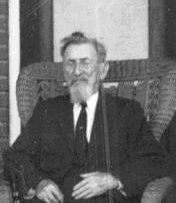
Lt. Col., Dallmeyer’s Six Moth Missouri Militia
William Q. Dallmeyer was born in Dissen, Hanover, Germany, October 23, 1829, the son of Johann Christopher Heinrich and Kathrine (von der Horst) Dallmeyer. He immigrated to America in 1845 where he worked in the dry goods business until 1849. He worked in New Orleans from 1849 to 1854 before coming to St. Louis, then to Gasconade County where he ran a general store and farmed. While there he was Justice of the Peace and Postmaster.
During the War he enlisted on September 8, 1861 and served in Capt. Cooper’s Co. of Home Guards and later as Lt. Colonel in Dallmeyer’s Six Month Missouri Militia. He was discharged in February 1862. In 1864 he was elected to the Legislature where he served until 1868 when he was elected State Treasurer. He moved to Jefferson City in 1868. In 1871, along with Nelson Burch, he organized a national bank, absorbing the Capital City Bank. Mr. Dallmeyer was cashier from 1874 to 1882 when he disposed of his interest, having been elected Cashier of the Exchange Bank.
He married Louise Sophia Lange in 1875 and they had six children, five of whom survived: Ferdinand P., Pauline, H. Rudolph, Viola and W. Augustus. Mr. Dallmeyer served on the Board of Education for 18 years and was a Mason. He made his home at 600 East Capitol Avenue in Jefferson City. Mr. Dallmeyer died on March 15, 1908 and is buried in Riverview Cemetery.
William Quintillian
Dallmeyer
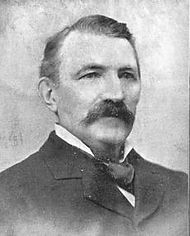
Co. I, 6th U. S. Cavalry
Leander Vaughn Dix (called L.V.) was born in Oneida County, NY in 1843, the youngest of three children born to Charles and Mary (Alden) Dix. He attended the public schools until he was sixteen years old, then he engaged in farming.
On August 5, 1861, he enlisted at Rochester in Company I, 6th United States Cavalry, and was assigned to the Army of the Potomac. He participated in all the principal engagements of the army: Fredricksburg, Antietam, the Peninsula campaign and Gettysburg. He then did scout and messenger duty at General Sheridan’s headquarters until the expiration of his term, and was discharged at “camp field” in front of Petersburg, August 4, 1864.
He spent a year traveling through Indiana, Michigan and Missouri looking for a place to settle. In March 1866, he purchased 160 acres about three miles west of Jefferson City. He built a house and expanded his holdings to 340 acres. In September 1868 he married Mary Conn, a native of Ohio and they had five children In November 1885, he purchased a farm known as the Maples, one mile west of Jefferson City and made a specialty of growing small fruit which he raised for market. He also bred and raised sheep and established a large herd of dairy cows. During 1880 and 1881 he was engaged in the lumber and tie business.
In the 1920’s he ran unsuccessfully as a Republican candidate for county judge. L. V.’s descendant, Tom “Soupy” Smith, continues to run the family nursery located on North Ten Mile Drive.
L. V. Dix

Surgeon, 47th Reg’t. EMM
Dr. M. A. Dunlop, one of the successful practitioners of Cole County, MO, was born in Knoxville, TN and came to Moniteau Co., MO with his father, William Dunlop. He went to the state of California during the gold excitement and remained five years. Shortly after his return he entered the office of Dr. E. H. Gregory, studied medicine and at the same time attended the St. Louis Medical College where he graduated in 1859.
Dr. Dunlop was surgeon of the Forty-seventh Regiment, Enrolled Missouri Militia during the war, being stationed at California, MO where he lived a few years before moving to Center Town. In 1864 he married Miss Amanda Wells, daughter of Judge J. W. Wells. To this union was born one child, Stella, who died in childhood. Mr. Dunlop was a staunch Democrat in politics.
Dr. M. A. Dunlop
32nd Reg’t. Inf. Vol, Co. F & S
Andrew M. and Jane G. (Anthony) Elston became residents of Cole County, MO about 1828, and located where the town of Elston now stands, the place taking its name from him. Their son, Addison, was born on December 6, 1830. He was reared and educated in Cole County and at the age of sixteen taught school. He was deputy county and circuit Clerk of Cole County at seventeen, and soon commenced to read law with General M. M. Parsons.
At the age of twenty years he began the study of medicine with Prof. H. Waters of the St. Louis Medical College, and graduated in 1864. Soon after he was appointed United States surgeon and assigned to duty at Jefferson Barracks. Subsequently he was commissioned surgeon of the Thirty-first Missouri Volunteer Infantry, and reported for duty at Atlanta, GA.
After the fall of Atlanta, he marched with Gen. Sherman’s army through Georgia to Savannah, and from there through South and North Carolina to Raleigh where the army was at the termination of the war. He was in all the battles in which the Fifteenth Army Corps was engaged during these marches. After the close of the war he went with the army through Virginia, by Petersburg and Richmond to Washington City.
In 1866 he began practicing medicine at Elston, MO, and in 1869 attended a course at Bellevue Medical College at New York City. In 1870 he received instructions at the medical department of the University of Pennsylvania and in 1871 located in Jefferson City where he built a large and lucrative practice. June 4, 1864, he was united in marriage to Miss Columbia Smith, by whom he had four children, two of whom survived, George and Addison.
Dr. Addison Elston
James T. Enloe
Captain, Co. B, 42nd Regt. EMM
James T. Enloe was born 5 miles northwest of Russellville in Cole County, June 24, 1838, the son of Enoch Enloe and Jane Compton Murray. In early life he was a school teacher. At the outbreak of the Civil War he organized a company at Russellville for the protection of the state capital. He was a second lieutenant of Company B, 42nd Regiment of Missouri Militia, and on August 29, 1864 he was promoted to Captain of Company B of the Enrolled Missouri Militia and also had a service record for a time in the 9th Regiment of Provisional Enrolled Militia.
After the war he was elected County School Commissioner. For a number of years he was in the lumber business at Olean, and from there he moved his business operations to Versailles, which was his home until 1909. After retiring from business he lived at Eldon for some years and then at Jefferson City, where he died.
Captain James Enloe married Mary Ryan, on March 20, 1863. Fifteen children were born of this union, several of whom died at a young age. Mary died on September 6, 1886, while giving birth to her second set of twins, whom passed away with her. James never remarried; he died April 14, 1917, at the age of 79. Both James and Mary are buried in the Enloe Cemetery, two miles west of Russellville, Missouri.
1st Lt., 62nd U.S. Colored Inf. Co. I
Richard Foster was born in Hanover, MA, Oct. 25, 1826, the son of Hezekiah Foster. He had one sister and six brothers. Richard graduated from Dartmouth College in 1851 and taught school in IL for three years. He married Jemima Ewing in 1851 and she died in 1852, leaving one son.
Richard fought slavery with John Brown in Kansas before the Civil War. He was a pioneer, farmer, teacher, and sawmill man in Iowa and Nebraska until he enlisted as a Pvt. in the 1st Nebraska Regiment in 1862. He was 1st Lieutenant with the 62nd Regiment, U.S. Colored Infantry, from 1863 to January 1866, serving 3 years 4 months.
The next 6 years of his life were spent founding the Lincoln Institute which was born of a contribution of $5,000 by his regiment.
As the first Principal of Lincoln Institute, Richard B. Foster acquired an abandoned school building on what was known as Hobo Hill in Jefferson City. In his search for quarters, he was turned back by all the churches in the city--refused by the Negro churches because he was white and refused by all the white congregations because his students would be black. He donated his services as an instructor without charge and black students began attending classes.
In 1872, Foster went to Osborne, KS where he was ordained as a minister and served for 10 years. He went to Stillwater, OK in 1890, then to Perkins and Okarche. He preached the first sermon preached in OK and served 30 years in the ministry.
In 1885 he married Lucy Reed and they were parents of 8 sons and 2 daughters. In 1898 his health began to fail and he cut back on his work, preaching only an occasional sermon. He died March 30, 1901 at age 74.
Pvt. 42nd Reg’t. EMM, Co. E - 1845-1899
The 8th and youngest child of John T. (1800-1866) and Elizabeth Berry, he was born on Moreau Creek farm in the Stringtown area. John W. served two different hitches with the Missouri State Militia during the war, but saw little or no action. The interesting part is that between hitches, while he was a college student in Warrensburg in 1864, he was captured by Sterling Price’s men during the “Raid on Missouri”. However, most of his Jefferson City family and friends (including Bob Young, Goodall, and other Gordons) were on the Confederate side, and through these connections, John W. was released by Price’s troops.
After the war he became very successful in business—shipping 150 train-car loads of cattle in a typical year, plus handling a huge grain business in several buildings at West Main and Harrison in Jefferson City. The buildings stood on the site of the James C. Kirkpatrick Information Center and State Archives.
John W. married Henrietta McMillan, daughter of Mexican War veteran, Capt. T. H. McMillan. They lived in one of Jefferson City’s finest homes at 429 East Main (now East Capital) and presently occupied by Buescher Funeral Home.
Pvt. 5th MO Cav.
Tandy was born in Wayne Co., KY and came to Cole Co., MO with his father, Christopher B. Greenup, at the age of seven. He was the fourth of six sons, five of whom were living at home when the War broke out. James L., Tandy A. and George W. served with the Union Army and Charles E., Samuel W. and Thomas served the Confederate Army.
At the battle of Wilson’s Creek, Charles and Samuel were on the Confederate side and Tandy was with the Union; all were wounded. Samuel was shot through the hips and thigh, Tandy was shot through the hand and Charles was shot in the arm and went on with his command. Tandy was taken home by his mother to recuperate. While he was convalescing, a squad of Confederates sent word that if he would surrender his horse, saddle and arms they would not molest him further; if he did not surrender they would burn his stepfather’s place. He responded that they would get nothing from him except at the point of a bayonet. The squad advanced on the house with burning hay, and as they came over the fence, Tandy fired at the head of one and shot him through the thigh. The others took to their heels and left.
Tandy rode to Georgetown, Pettis Co., where he enlisted and served in the Fifth Missouri Cavalry. At Swas Prairie, MO he was wounded in the knee, rendering him crippled for life. At the end of four months he was back again in the ranks, and was with his regiment until the battle of Cane Hill, AR when he was wounded again in the same knee. He rejoined his regiment in two months and served until his term expired, April 23, 1865.
July 12 he re-enlisted in Co. F, 2nd Veteran Cavalry and remained until August 26, 1866 when he was mustered out at Salem, MO.
After the war he was employed by the MO Pacific Railroad and later kept a hotel in Center Town. He married Miss Martha A. Schaufler and they had five children, two sons and three daughters. Mr. Greenup was Justice of the Peace and Center Town and also held the office of deputy assessor and collector. Later he became post master.
Co. F, 3rd Regt, KS Infantry
Cole County Home Guard
William Koestner was born and lived all his life in the Zion community southwest of Jefferson City, MO. In 1863, when he turned sixteen, he volunteered and was admitted to the Cole County Home Guard. Their main duty was to provide security for the citizens in the county and surrounding areas. Most of the Home Guards in central Missouri were pro-Union, due in part to the fact that central Missouri had a large German immigrant population, the vast majority of who were opposed to slavery and racial oppression.
When the war ended in 1865, Koestner was given one hundred dollars by the county. He then returned to his farm near Jefferson City. Koestner had the honor of wearing his Civil War uniform and marching in the Governor’s parade during the inaugurations every four years, usually riding in the same vehicle as the Governor. His last inauguration ride was with Governor Lloyd Stark in 1931.
Koestner died in 1932 while digging out a tree stump on his farm. He was eighty-five years of age. He is buried in the Zion Lutheran Cemetery south of Jefferson City.
Major, 42nd Reg’t EMM
James W. Legg was the eldest son of Samuel and Elizabeth Legg and thus a half-brother of Polly Roberson Strong nee Legg. James served as an officer in the Home Guards, the 42nd Regiment Enrolled Missouri Militia and the 25th Missouri Militia during the Civil War. It is interesting that all the sons of Samuel Legg served on behalf of the Union, since Samuel was a slave-owner. James served as a Private in the 5th Reg’t. Cavalry State Militia, Co. E. as well as the Cole County Home Guards. He was a Private in Cole Infantry in July 1846, which was part of the forces commanded by General Sterling Price in the Mexican-American War.
James was born October 7, 1822 in McMinn County TN and married Mary Ann Wear on November 16, 1843 in Stringtown, Cole County, MO. She was born in Ohio on December 17, 1827 and died on August 9, 1901 in McDonald County, MO, and was buried there in Fairview Cemetery.
In 1864 James was elected a County Judge in Cole County. In the 1870 US Census he is farming in Morgan County with the following family in the household: daughters Mary, Sarah, Martha and Eugean; sons John, Henry, Frank and James. By 1880 the family had moved to McDonald County. James died there on February 23, 1902 and is buried in Fairview Cemetery.
10th MO Cav.
Gustav Loesch was born on his father’s farm four miles south of Jefferson City. He always lived on a farm and was active in farm work.
His regiment was the 10th Missouri Cavalry which preceded Sherman in his drive through the South. “We just started things and let the infantry finish them up”, was his modest description of the part his regiment played in winning the war between the states. He also gave a word picture of the “flying artillery” used during that war. Small howitzers were mounted on wagons drawn by four mules and were the fastest artillery guns employed.
Loesch was taken prisoner by the Confederate army on February 26, 1864, and was released one year later. He was held at the Andersonville, GA prison, later moved to Florence, NC, and from there to several other smaller prisons. During that time he saw many hundreds die from starvation, disease and ill treatment. In his later years he lived with his daughter, Mrs. Ira C. Mulvaney, at 123 East Atchison in Jefferson City. Gus was the sole survivor of the Union Army living in Jefferson City in 1943. A special gala was held at the VFW on March 28 of that year to celebrate his 100th birthday. Governor Forrest C. Donnell attended along with over 1,000 guests.
Maj. 10th Reg’t Cav. Vol.
William H. Lusk was born in Cumberland Co., PA on September 5, 1827, son of William and Mary (Fitzsimmons) Lusk. The family moved to Cole Co. in 1839 and settled on a farm near Marion. In 1840 they moved to Jefferson City and purchased the Jefferson Inquirer where William apprenticed until his majority, when he became a partner in the paper with his elder brother, James.
During the Mexican War, young William served as a Pvt. In Capt. John Knapp’s Co. C, First MO Infantry, and saw duty in Matamoras. October 2, 1856, he married Abbie Maria Burgess, who died June 9, 1859, leaving two children: Mary Belle and James Abbie.
Upon his brother’s death in 1858, William took exclusive charge of the newspaper where he struck out boldly and fearlessly for the Union. In March 1861, the paper went down and William became the confidential correspondent of Frank P. Blair and the then Capt. Lyon in command of the U.S. Arsenal at St. Louis. Facts obtained through his correspondence contributed to the removal of Gen. Harney and the capture of Camp Jackson. He served for 3 months as Capt. of Co. B, Col. Richardson’s Regiment, U.S. Reserve Corps. He was then appointed Asst. Provost Marshall and served until he was commissioned as recruiting officer with the rank of Lt. and raised four companies of U.S. Volunteers. On Sept. 1, 1862, he was promoted to Capt. and assigned to Co. E, which later formed a part of the Tenth MO Cavalry. On Dec. 4, he was promoted to Major of the Regiment and held the position until the close of the war.
He took part in the capture of Gen. John S. Marmaduke, Gen. Gabell and some 300 prisoners at the battle of Osage, KS October 25, 1864. In the early part of 1865, the Regiment was assigned to the Cavalry Corps of the Military Division of the Mississippi and participated in the celebrated raid through Alabama and Georgia. Maj. Lusk was chairman of the Cole Co. Democratic Committee and ran unsuccessfully for the Legislature in 1866. In 1870 he was elected Clerk of the Circuit Court and Ex-officio Recorder. Feb. 1, 1871, in Pittsburg, PA, he married Christine Hager.
Pvt. 1st Reg’t. MSM, Co. B
He was the son of Stockley D. and Susanna Montgomery Manes (misspelled Manas), and was born in Green Co., TN Oct. 22, 1846. He married Jane E. Rose in Sullivan, MO Feb. 22, 1866 and they had 6 children, 3 of whom survived: John W., Samuel L., and Susanna, wife of Robert Simmons. Jane died Nov. 19, 1882. His second marriage was to Nettie Coolie who did not survive long. His third marriage was to Nannie Atkins at Sedalia, MO and they had 3 children: Stokley D., George and Mary A.
William enlisted from Linn Co., MO Aug. 6, 1863 and served 3 years. The command was largely engaged by detachments on guard and provost duty, and in the defense of the State against the rebel Generals Quantril, Marchbank, Shelby and Price. The command bore a conspicuous part in the battles of Independence, Big Blue and Osage and performed escort and guard duty of the prisoners captured during this campaign, and held at Warrensburg, MO. The regiment was mustered out of service at Warrensburg, MO in February 1865.
Mr. Manes was a charter member of George R. Smith Post #53, Grand Army of the Republic. His father, Stokley D., served in four regiments for the Mexican War; his grandfather, William Montgomery, died in the war of 1812; his paternal grandfather, Bartholomew Manes, served in the war of 1812. His first wife’s father, Hiram Rose, served in a MO Regiment in the Civil War, was captured at Franklin, TN, and confined for 9 months in Andersonville Prison, GA.
Co. A, Cole Co. Home Guards - 5th Reg’t. Cav Vols, Co. E
Charles B. Maus was born in Germany, December 3, 1823 and immigrated to America with his family in 1830. They first lived in Lancaster Co., PA and when his father died, the family moved to Tuscarava Co., OH. When his mother died, the children moved to Jefferson City. Charles worked first as a carpenter then apprenticed as a stone mason. In 1846 he enlisted for the war with Mexico, following which he engaged in merchandising, selling chickens, produce, etc to river boats. He first associated with C. F. Lohman and when the firm dissolved, continued on his own from a building at Water and Jefferson Streets.
In 1861, he joined the Union cause, first as a Pvt. later being promoted to Sgt, Lt., and Capt. He served 3 years mostly guarding wagon trains carrying supplies from Rolla, the end of the railroad to Sand Springs. Mr. Maus was married to Amelia Linsenbarth and they had 4 children. Following her death in 1858, he married Margaret Blochberger who was the mother of 6 children.
His brother, Christopher, also served in the Home Guards, but another brother, Thomas, is said to have fought for the South. Charles’ “Union Hotel” and Christopher’s brick home are preserved in Jefferson Landing State Historical Site.
Charles was a Republican and a Christian Scientist. He donated property to the Christian Science organization for a church building site.
He made his home above his store at the corner of High and Jefferson Street. In addition to his mercantile interests, he had a 240 acre farm cross the river in Callaway Co.
Sgt. 43rd Reg’t. EMM, Co. G
Pvt. 42nd Reg’t. EMM, Co. G
Adam Opel, a contractor and builder of Jefferson City, was born in Bavaria, Germany, in 1821, the son of
John and Margaret (Keisling) Opel. The family immigrated to America in 1849, the father dying before they
reached St. Louis. After 11 months in St. Louis, Adam settled in Liberty Twp., Cole Co. to farm until 1852
when he moved to Jefferson City where he learned cabinet-making and carpentry.
Mr. Opel was first married in Germany to Barbara Schoetel who died in Cole Co. in 1851, leaving one child,
George. Mr. Opel next married L. Denking and they had two children, Carrie and Charlie. When his second
wife died, Adam married Margaret Mayer in 1879; they had three children, Louie, Hilda and Anna. Adam
Opel was a member of the Baptist Church where he served as trustee. His wife was Presbyterian. The
family home was located at 505 Jefferson Street.
He was in the Home Guard and State Militia during the War and was a Republican in politics. Adam
served as city alderman. His brother, Capt. John Opel was also a carpenter in Jeff City.
Sgt. 26th Reg’t. Inf. Vol.
John was born near Canterbury, Kent, England, April 5, 1817 and immigrated to the United States when
eleven years of age, settling in Albany, N. Y. At the age of 16 he became an apprentice to James Burdick
to learn the carriage painting trade. He married Mr. Burdick’s daughter, Lydia Elizabeth on Nov. 23, 1824.
When his father-in-law died, he successfully took over his business, until it was destroyed by fire.
John took a position in VT painting railroad cars and continued his trade until health forced him to quit.
They moved to Castle Rock, Osage Co., MO where he engaged in farming and merchandising. During the
Civil War he had 3 mail contracts, from Jefferson City to Rolla, Little Pina (on the Osage River), Castle Rock.
He recruited for the 26th MO Infantry.
Mr. Price came to Jefferson City in December 1863 and joined the Home Guards, guarding armaments
from Jefferson City to Rolla. He and Dr. Peabody acted as Trustees and started the first public school in
Jefferson City after the War. He resumed his painting trade and formed a partnership with John Ross.
Mr. & Mrs. Price were parents of nine children.
Maj. Gen. Thomas Lawson Price - 1809-1870
He was married to Lydia Bolton and reputed to be the wealthiest man in Jefferson City in his time, owning many slaves and living in a mansion where the Supreme Court Building now stands. The home was built by Bob Young’s father, William C., Young, and was used by a number of Missouri’s governors and first ladies to host formal receptions.
Tom was a successful merchant, investing his profits in land, the primary source of his wealth. He opened the first stage line from Jefferson City to St. Louis, founded a bank and a savings and loan company, was a major contractor in the building of the Missouri Pacific Railroad, and a large investor in other railroads.
After Jefferson City incorporated in 1839, he was the town’s first mayor. Later he became Lt. Governor of Missouri. A “Benton Democrat”, he served in the state legislature and went to the US Congress in 1862. While in Congress he was also a Major General in the Union Army, and for a time, commander of the federal troops in Jeff City.
Within a few months of the War’s end, his daughter, Celeste, married the son of General Sterling Price.
To many in Cole Co., Tom is best remembered for his efforts during and after the War to restore freedom and property to many citizens that were disenfranchised at that time.
Pvt., 42nd Reg’t., EMM, Co. I
Bernard was born in Germany October 27, 1820, the son of Anthony and Mary (Peters) Richter. In 1846, Bernard Richter immigrated to America, landing in New York, and afterward made several trips back to Germany. In 1853 he started to California, but stopped in Jefferson City and there met and married Mary Tollman the same year. They had six children: Antone, born in 1854; Herman, born in 1856; Henry, born in 1858, Anna, born in 1860; Elizabeth, born in 1864, and Mary, born in 1868.
Mr. Richter purchased his place of residence, 155 acres, on Greenberry Road in 1853. One hundred acres were under cultivation with a five acre orchard as well as livestock.
During the war, Bernard was enrolled in the Home Guard and the State Troops, making but one raid, that being to Rocheport. He was Justice of the Peace at one time, but resigned. A Democrat in his politics, he and his wife were members of the Catholic Church.
Sgt., 9th Prov. Reg’t, EMM, Co. F
Adam Routszong was born in 1836 near Frederick City, MD, the son of Levi and Sarah (Mentzer) Routszong.
He is a brother of John M. Routszong. Around 1840, his family came by steamer to Jefferson City where his
father briefly ran a mill before he began farming. In 1867 Adam married Harriet C. Peninger and they had six
children: William Levi, Sarah Elizabeth, John H., Harriet Leona, Susan Ellen and James P.
About 1856, Mr Routszong began working in the store of C. F. Lohman, but in 1860 entered into partnership
with A. W. Morrison, then MO State Treasurer, and opened a store at Morrison’s Station in Gasconade Co.,
continuing one year, when he sold out and came back to Cole Co.
During the war he served in the State Militia. Due to a disability, he was unable to join the regular service but
did some hard service with the State troops fighting bushwhackers and raiders. When discharged he went to
work for Mr. Lohman. In May 1865 he began merchandising in Cedar City, continuing until 1867 when he
purchased a 200 acre farm near Elston. In politics he was of old-line Whig stock and voted Republican. He and
his family were Cumberland Presbyterians.
Pvt., Cole Co. Home Guard, Co. E
John Routszong was born in Ohio, the son of Levi and Sarah (Mentzer) Routszong. He is a brother of Adam Routszong. Around 1840, his family came by steamer to Jefferson City where his father briefly ran a mill before he began farming.
John married Frances E. Walker in 1866 and they had four children: David E, Sarah Mona, Annie L, and Susan Edna. One child died in infancy. Mr. Routszong purchased a 245 acre farm about a mile and a half from Elston Station the same year he was married.
During the War, John served in the MO Militia for about 3 months and was located in Jefferson City. He voted the Republican ticket. He and his wife were members of the Methodist Episcopal Church.
Mrs. Routszong was a daughter of Jacob and Mary (Hogan) Walker and grand-daughter of David Walker who was a member of Congress from Kentucky and a soldier in the War of 1812. His son, David was governor of Florida. Martin Hogan was one of the early settlers of KY and through him, Mrs. Routszong was related to President Benjamin Harrison.
Pvt., 1st Regt., U. S. Reserve Corps
John H. Sanning was born November 8, 1830 in Hespertwist, Germany, the son of Francis/Franz Leopold
Sanning and Anna Margaretha Jansen. He immigrated with his parents and three siblings to Taos in 1841.
John married Adeleid Bruning in Cole County and they were the parents of 10 sons and 1 daughter. They had
a farm on the Osage River east of Taos. He suffered a leg wound on maneuvers; it remained an open wound all
his life. John Sanning died at his home on November 8, 1914 at the age of 86 years.
His wife died in February 11, 1914. Both are buried at St. Francis Xavier Church Cemetery in Taos.
Captain, Co. F, Home Guard
Franz/Francis Leopold Sanning served as a Captain in the Home Guard, organized October 1, 1861 to defend the state capital against marauding troops. He was about 63 years old.
Francis (1799-1873) and Anna Margaretha Jansen (1805-1875) were born in Hesepertwist, Germany, on the Netherlands border. At that time the area was called Prussia, now we know it as Germany. In 1840, they brought their children, Herman, Marie, Helen and Henry to this country and settled in the community of Haarville, now known as Taos. Immigration records listed Francis’ occupation as “zimmerman” or carpenter.
Frank and Margaret died in Taos and are buried in the old Taos Cemetery.
42nd Reg’t. EMM, Co. K
Judge Schell, merchant and farmer of St. Thomas, Osage Twp., Cole County, MO, was born in Ohio on February 18, 1840, the son of Simon and Mary (Laux) Schell. In 1841, the family moved to Cole Co., MO.
In April 1863, Simon married Elisabeth Wankum, who bore him eleven children, seven living: George W. born May 2, 1871; Martha C born September 4, 1873; Peter J. born April 13, 1881; Matilda born May 22, 1884; and Sarah born September 22, 1886.
Mr. Schell was chosen County Judge at large in 1886. Previous to that he was District Judge for two years and was also Justice of the Peace for 12 years, and Notary Public. Additionally he farmed and ran a mercantile business in partnership with his sons George and Simon.
During the war he was in the State Militia for a short time. Mr. Schell was a Democrat and a strict adherent to the Catholic Church as was his whole family.
Capt., 42nd Reg’t., EMM, Co. H
On May 9, 1839, Jacob Schirmer was born in Weister, Bavaria, Germany, the son of John M. and Margaret (Schoeffel) Schirmer. His father was a blacksmith by trade. The family immigrated to PA in 1861 then came west and settled in Osage City. Both parents died in 1867, leaving three sons: Andrew, Jacob and Lawrence.
During the War, Jacob was in the Home Guard as Orderly-Sergeant then joined the State Militia and served until the end of the war. After the War he was engaged in merchandising for a short time and then in the steamboat business. In 1879 he came to Jefferson City as jailer and deputy marshal, serving as such for four years. Afterward, he filled the position of marshal of Jefferson City and later became Chief of Police.
Jacob married Elizabeth Maggie Diedel and they had two children: Eliza Maggie and Charles Henry, a telegraph operator. Jacob was a member of the GAR and the IOOF; his wife was a member of the German Lutheran Church.
Sgt., 62nd Reg’t. U.S. Colored Inf., Co. E
Buck Shelby was one of the founders of Lincoln Institute (later known as Lincoln University).
He was from Sedalia and enlisted in December, 1863 in Tipton, MO, serving under Captain Woodward.
Shelby was discharged in December 1864 at Brownsville, TX and returned to Sedalia to live with Nancy
Shackleford who was also a former slave.
175th OH Inf., Co. A
M. R. Sinks was born in 1843 in Clermont Co., OH. He attended Ohio Western University and engaged in the mercantile and drug business there. He was at Peru, IN for five years and published the Peru Republican and later the Connersville Times. In 1854 he enlisted in Company A, 175th Ohio Infantry, and was in the battles of Franklin and Nashville.
In 1865, Marquis was married to Belle Stiles, who bore him four children, none of whom survived.
In 1878 he came to Cole Co. with the intention of farming, but his wife, being an invalid, preferred to remain in the city. M. R. engaged in the grocery business and they made their home in the 500 block of High Street.
He was a member of the AOUW, a Select Knight, and he and his wife were members of the Methodist Church since childhood.
Co. F, 117th IL Infantry
George Spurr was born in St. Louis Co. in 1839, the youngest of seven children born to Dorothy (Maddox) and William Spurr. His mother died when he was born. His father was a cabinet maker.
George trained as a blacksmith and was in his first year of college when the War broke out. He left school and enlisted in the infantry, and was assigned to the Army of the Cumberland, but was soon afterward assigned to the 16th Army Corps of the Army of the TN, and took an active part in the battles of Nashville, Pleasant Hill (LA), Mobile (AL), Overton Hill (MS), Tupelo (MS), and was in 33 engagements of less note.
After three years of hard service he was mustered out at Camp Butler in Springfield, IL in 1865, and after six months in IL came to MO where he worked in Moniteau CO. in the stove factory belonging to John Howe of St. Louis. During this time he married Katie S. Webber and they had six children, three of whom survived: Lawrence S., Olive and Emma. William U. died at age 4 years and Georgie and Benjamin at age 3.
In 1867, George engaged in farming on rented land, and four years later bought a farm of 45 acres on Grey’s Creek, where he resided until 1875 when his house was destroyed by a cyclone. In 1880 he sold his farm and bought 50 acres on the Booneville Rd., six miles from Jefferson City, where he built a house and barns. It was all under fence and cultivation and had an orchard of 200 apple trees.
George was a Republican in politics and quite active in school matters, serving a number of terms as school director and clerk of the district. He and family members were members of the Baptist Church.
Pvt., Cole Co. Home Guards, Co. B
Judge Joseph Stampfli was born October 5, 1840 in Canton, Solothuria, Switzerland. His father, John Stampfli, was a merchant tailor by trade and came to Jefferson City in 1853. Joe apprenticed in the printing business but quit because of ill health.
He served in the Home Guard in the War but was compelled to abandon his duty on account of ill health. However, he followed the army work, organizing and mustering in 2-3 companies of soldiers.
In 1866, he was appointed deputy sheriff and collector under G. H. Dulle, and served about 4 years. He then spent 9 years as bookkeeper for Mr. Dulle before quitting due to poor health. In 1871, he was elected City Alderman, serving one term. In 1875 he became a dealer in furniture and undertakers’ goods. He served as secretary and vice-president of the School Board. In 1882 he was elected presiding justice of Cole Co. Court.
Joe married Elizabeth Kolkmeyer who died in 1874, leaving him with two sons and two daughters.
In 1876 he married Josephine Philomena Hager, nee Freyvogel. The Stampflis were members of the Catholic Church. He was also a member of the Jefferson City Building & Loan Assn.
Home Guards
John A. Summerer was born in Cole County January 9, 1853, the son of Mathias and Barbary (Dingle) Summerer, both natives of the Kingdom of Bavaria. John’s parents immigrated to America in 1840 and John was one of the oldest settlers of Cole Co, Suffering many hardships during the early days of the country.
On March 2, 1880, John married Annie Sceiegler, a native of Cole County who was born in 1858. They had four children: Henry M., born January 29, 1881; Mary, born in 1883; Louis, born in 1885; and Otto, born in 1888.
John was a Republican in politics, and during the Civil War served in the Missouri Home Guards. Mr. Summerer had a fine farm of 350 acres, with 125 acres well improved and cultivated. He had good barns, out buildings and an unusually nice frame residence. He was a Republican in politics and is a member of the Lutheran Church, as is his family.
Capt., 2nd Mass. Inf.
Mr. Thomas was born in Boston on July 26, 1841, his ancestors having settled there in 1650. He worked in the dry goods business until July 1862, when he enlisted as a private in the 2nd MA Inf. For brave and gallant service in a number of battles of the Army of the Potomac, he was made Lt. His regiment, along with others, met and repulsed the assaults of Lee’s army at the Battle of Gettysburg; when his captain was injured, command fell to Lt. Thomas. Returning to the Army of the Potomac, they joined the 12th which was consolidated with the 11th, becoming the 20th, commanded by Gen. Hooker, and were sent west to the Army of the Cumberland. Capt. Thomas was continually on the firing line in General Sherman’s GA campaign.
Following the War, Capt. Thomas came to Jefferson City and during the administration of Gov. Fletcher held a clerkship under the Adjutant-General of the State. In 1869 he embarked on the grocery business and continued to his death on December 31, 1899.
On October 16, 1866, he was united in marriage to Ophelia Bolton, daughter of Dr. Wm. Bolton, a prominent physician. Mr. & Mrs. Thomas had four children: Charles Kent (who died in infancy), William Edgar, Cecil and Theodore. The family lived on East Main Street.
Capt. Thomas was a Republican and a member of the G.A.R and of the Loyal Legion. He is buried in Woodland Cemetery.
Surgeon, 13th & 19th IL Vol.
Dr. C. A. Thompson, a native of Sandusky, Ohio, was born on the 27th of March, 1824, the son of Giles and Mary (French) Thompson. He was reared in Michigan, and educated in White Pigeon University at Branch.
He began the study of medicine when twenty-one years of age and in 1849 graduated from the Indiana Medical College, entering practice at Lima. In 1854, he married Maria E. Kenney, a native of Vermont. In 1856 he moved to Urbana, IL where he remained until the close of the war.
Dr. Thompson was surgeon in the 13th and 19th IL Regiments for over four years, and in 1865 he came to Jefferson City where he opened a medical practice.
He was physician for the penitentiary and served for twenty years as President of the Board of Pensions. Dr. Thompson served for twenty years as Secretary of the Missouri Medical Association. He was President of the Board of Medical Examiners and a commissioner of the “Deaf and Dumb Institute” in Fulton. He was a Republican in politics, an eminent physician and surgeon. Dr. Thompson died December 15, 1898.
15th & 33rd U.S. Inf.
John Tweedie was born in Moffat, Dumfries Shire Scotland, Sept. 28, 1838. He learned the shoe-making trade in his father’s shop. The family immigrated to America, Living in NY and RI. In 1861 he moved to CT where he joined the 2nd CT Vol., serving a couple of months. He then enlisted in the 9th RI and later the 15th and 33rd regular U.S. Inf. where he was promoted to Sgt. He fought in the first battle of Bull Run and was with Gen. Sherman in his GA campaign. Following discharge in 1867 in Macon, GA, he became Supt. of the Andersonville National Cemetery.
In 1869 John went to St. Louis where he resumed his shoemaking trade. In 1874, he came to Jefferson City in a management capacity with the Priestmeyer Shoe Company.
On May 1, 1867, Mr. Tweedie was united in marriage at Macon, GA to Anna DeBeruff. They had 10 children, four died in infancy. The family resided at 601 East High Street.
Mr. Tweedie was a member of the G.A.R., I.O.O.F, A.F. & A.M., Royal Arch Chapter and Commandery.
George Wagner
Pvt., Cole Co. Home Guards, Co. C
George Wagner was born February 13, 1821 in Kulmbach, Bavaria, Germany to Paul and Caroline
(Seidel) Wagner. The family immigrated to America in 1842 and settled in Cole Co. George
engaged in farming until 1842 when he opened a small brewery. He married Catherine Wolfrum
and they had seven children: Conrad, Lawrence, William W., Henry, Christopher, Louis and Theresa.
Conrad and Lawrence were partners in the brewery. William was proprietor of the Monroe House,
Henry was in the saloon business and Louis practiced law in Jefferson City.
Mr. Wagner was a stockholder of First National Bank and extensively engaged in farming. He
served two terms as sheriff, elected on the Republican ticket, and served one term on the
city council. During the war he did active duty in the Home Guards. The family worshipped
at the Lutheran Church.
10th MO Volunteer Cavalry
James Yates was born in Virginia but fought for the Union. He was 29, married and a farmer in Cole
County when he enlisted with his brother John in 1862. James survived but John was
not so lucky—he died in St. Louis in 1863 at the age of 26.
Sgt., 10th Reg’t. Cav. Vol., Co. E
Victor Zuber was born in Switzerland, the son of Jerome Zuber, a stone mason. The family immigrated to America and Jefferson City in 1852. After arriving here, Victor served a 3 year apprenticeship as a stone mason.
In 1862 he enlisted in Co. E, 10th MO Cavalry and was discharged in July 1865. He served in numerous skirmishes of his regiment and was wounded in October 1864 near Ft. Scott. At the close of the war he went to Boonville and worked for a year as a journeyman before returning to Tipton where he engaged in the marble business. In 1867 he moved to Jefferson City and established his business, employing three men.
Mr. Zuber married Louisa Breinersen and they had five children: Burnettie, Zarelda, Mary, Frank and Cletus. The family belonged to the Catholic Church. In politics he was a Democrat and served 3 years as a member of the school board and three years on the city council. He was treasurer of Cole County four years and a judge from the First District. The family resided at 306 South Jefferson Street.
Richard Baxter Foster
John W. Gordon
Tandy A. Greenup
Captain James M. Jobe


James M. Jobe was born October 24, 1841 in Osage County, MO, the son of Edward J. Jobe and Isabelle Fincher. He lived in Osage/Cole County from birth to about 1860 when he moved to Linn Co., KS with his parents. He enlisted in Co. I, 10th Kansas Infantry on July 24, 1861, and was promoted to the rank of Captain on December 16, 1861. James mustered out on August 19, 1864 and returned to Jefferson City where he worked as a prison guard and was later City Marshall of Jefferson City. He died on October 11, 1918 and is buried in an unmarked grave in Woodland Cemetery.

James W. Legg

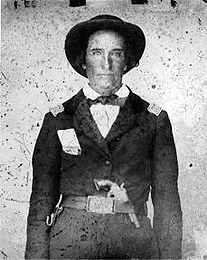
William Koestner
Gustav Loesch

William H. Lusk
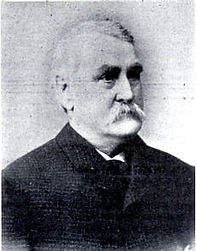
William R. Manes
Captain Charles B.
Maus
Herman Henry Neef
H. H. Neef was born July 18, 1833, in Baden Germany and died at his home in Jefferson City, MO March 31, 1900. His father was a wealthy and prominent citizen, owning a large hotel in Constance. The family was politically active in the Revolution against the Grand Duke and forced to flee the country. They made their way singly to America where they were united in Carbondale, IL and moved to St. Louis where his mother died. Mr. Neef came first to Jefferson City then to Tipton where he opened a hardware store. Within a few years he had stores in Tipton, Sedalia, Warrensburg and Versailles. He became very wealthy and retired, establishing a large brewery in Tipton which was destroyed by fire. He then opened a large hotel that was very successful, but within six months it too was consumed by fire.
He moved to Jefferson City and opened a hotel, doing a good business for 6 years, when he leased the old Tennessee House. Mr. Neef was married Feb 1, 1858, to Mary G. Brenneisen and they had five daughters and one son. While in Tipton he served his community as a member of the School Board, City Councilman and City Treasurer.
In 1861 he enlisted as a Sgt. in Co. H, Cole Co. Home Guards. He then enlisted in the Enrolled Missouri Militia and was commissioned Lieutenant.
He was a Democrat and a Catholic. He is buried in the St. Peter Cemetery.


Adam Opel

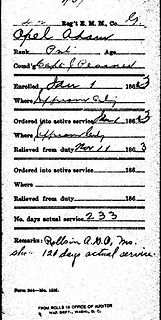
John W. Price


Thomas Lawson Price
Bernard H. Richter
Adam Routszong
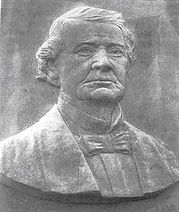

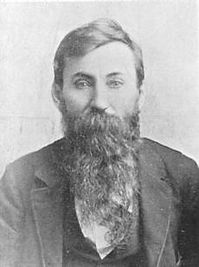
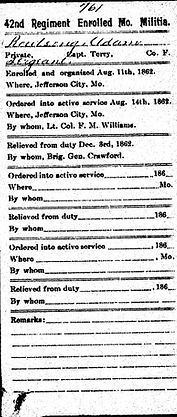
John M. Routszong
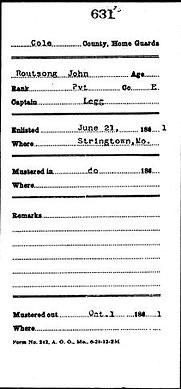
John Herman Sanning
Franz Leopold Sanning
Simon N. Schell
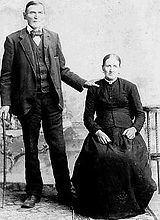


Jacob Schirmer

Buck Shelby
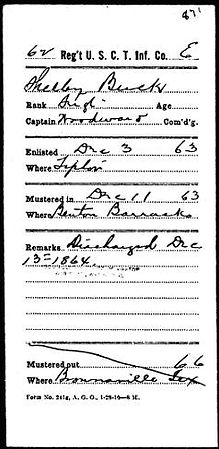
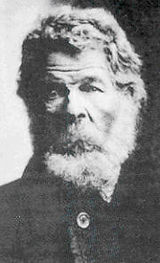
Marquis/Marcus R.
Sinks
George W. Spurr
Joseph Stampfli
John A. Summerer
Charles W. Thomas
Charles A. Thompson

John Tweedie, Sr.
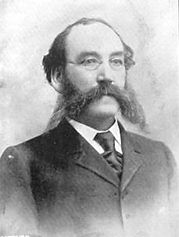
George Wagner

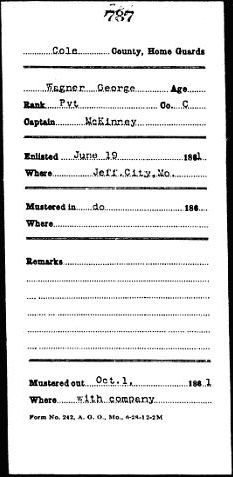
Pvt. James Franklin
Yates
Victor Zuber
